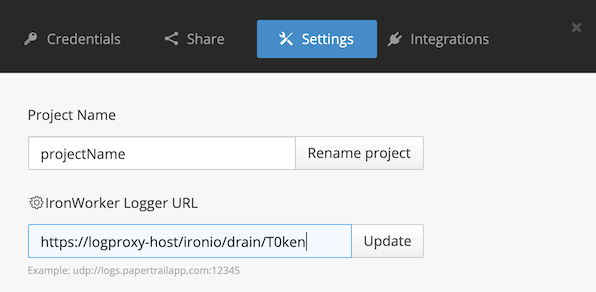A microservice which acts as a logdrain and forwards messages to HSP Foundation logging. Supports the new v2 single tenant solution.
- Cloud foundry logdrain endpoint
- IronIO project logging endpoint
- Batch uploads messages (max 25) for good performance
- Very lean, runs in just 32MB RAM
- Plugin support
- Filter only mode
- OpenTracing support
- IAM Service Identity support
Logproxy is distributed as a Docker image:
docker pull philipssoftware/logproxyBy default Logproxy uses RabbitMQ for log buffering. This is useful for handlingspikes in log volume. You can also choose to use an internal Go channel based queue.
| Variable | Description | Required | Default |
|---|---|---|---|
| TOKEN | Token to use as part of logdrain URL | Yes | |
| HSDP_LOGINGESTOR_PRODUCT_KEY | Product key for v2 logging | Yes (hsdp delivery) | |
| LOGPROXY_SYSLOG | Enable or disable Syslog drain | No | true |
| LOGPROXY_IRONIO | Enable or disable IronIO drain | No | false |
| LOGPROXY_QUEUE | Use specific queue (rabbitmq, channel) | No | rabbitmq |
| LOGPROXY_PLUGINDIR | Search for plugins in this directory | No | |
| LOGPROXY_DELIVERY | Select delivery type (hsdp, none, buffer) | No | hsdp |
| LOGPROXY_TRANSPORT_URL | The Jaeager transport endpoint | No |
| Variable | Description | Required | Default |
|---|---|---|---|
| LOGPROXY_SERVICE_ID | IAM Service ID | Yes (hsdp delivery) | |
| LOGPROXY_SERVICE_PRIVATE_KEY | IAM Service Private Key | Yes (hsdp delivery) | |
| LOGPROXY_REGION | IAM Region | Yes (hsdp delivery) | us-east |
| LOGPROXY_ENV | IAM Environment | Yes (hsdp delivery) | cllient-test |
| Variable | Description | Required | Default |
|---|---|---|---|
| HSDP_LOGINGESTOR_KEY | HSDP logging service Key | Yes (hsdp delivery) | |
| HSDP_LOGINGESTOR_SECRET | HSDP logging service Secret | Yes (hsdp delivery) | |
| HSDP_LOGINGESTOR_URL | HSPD logging service endpoint | Yes (hsdp delivery) |
Clone the repo somewhere (preferably outside your GOPATH):
$ git clone https://github.com/philips-software/logproxy.git
$ cd logproxy
$ docker build .
See the below manifest.yml file as an example.
applications:
- name: logproxy
domain: your-domain.com
docker:
image: philipssoftware/logproxy:latest
instances: 2
memory: 64M
disk_quota: 512M
routes:
- route: logproxy.your-domain.com
env:
HSDP_LOGINGESTOR_KEY: SomeKey
HSDP_LOGINGESTOR_SECRET: SomeSecret
HSDP_LOGINGESTOR_URL: https://logingestor-int2.us-east.philips-healthsuite.com
HSDP_LOGINGESTOR_PRODUCT_KEY: product-uuid-here
TOKEN: RandomTokenHere
services:
- rabbitmq
stack: cflinuxfs3
Push your application:
cf push
If everything went OK logproxy should now be reachable on https://logproxy.your-domain.com . The logdrain endpoint would then be:
https://logproxy.your-domain.com/syslog/drain/RandomTokenHere
In each space where you have apps running for which you'd like to drain logs define a user defined service called logproxy:
cf cups logproxy -l https://logproxy.your-domain.com/syslog/drain/RandomTokenHere
Then, bind this service to any app which should deliver their logs:
cf bind-service some-app logproxy
and restart the app to activate the logdrain:
cf restart some-app
Logs should now start flowing from your app all the way to HSDP logging infra through logproxy. You can use Kibana for log searching.
Below is an example of an HSDP LogEvent resource type for reference
{
"resourceType": "LogEvent",
"id": "7f4c85a8-e472-479f-b772-2916353d02a4",
"applicationName": "OPS",
"eventId": "110114",
"category": "TRACELOG",
"component": "TEST",
"transactionId": "2abd7355-cbdd-43e1-b32a-43ec19cd98f0",
"serviceName": "OPS",
"applicationInstance": "INST‐00002",
"applicationVersion": "1.0.0",
"originatingUser": "SomeUsr",
"serverName": "ops-dev.apps.internal",
"logTime": "2017-01-31T08:00:00Z",
"severity": "INFO",
"logData": {
"message": "Test message"
},
"custom": {
"key1": "val1",
"key2": { "innerkey": "innervalue" }
}
}The IronIO logdrain is available on this endpoint: /ironio/drain/:token
You can configure via the iron.io settings screen of your project:
Logproxy maps the IronIO field to Syslog fields as follows
| IronIO field | Syslog field | LogEvent field |
|---|---|---|
| task_id | ProcID | applicationInstance |
| code_name | AppName | applicationName |
| project_id | Hostname | serverName |
| message | Message | logData.message |
You may choose to operate Logproxy in Filter only mode. It will listen
for messages on the logdrain endpoints, run these through any active
filter plugins and then discard instead of delivering them to HSDP logging.
This is useful if you are using plugins for real-time processing only.
To enable filter only mode set LOGPROXY_DELIVERY to none
...
env:
LOGPROXY_DELIVERY: none
...
See the Logproxy plugins project for more details on plugins.
- Better handling of HTTP 635 errors
